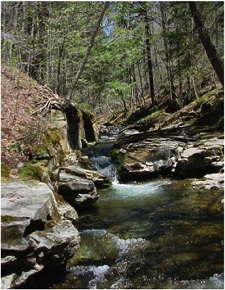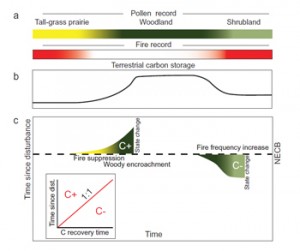
In a recent paper (Ecological Impacts, Vol. 39, pp. 94-101), Carrie Levine and colleagues describe methods for analyzing long-term monitoring data to evaluate whether current monitoring programs are as efficient and effective as possible. This can allow researchers to maximize information gained relative to resources required for data collection. In the paper, the authors describe methods for analyzing data from four types of monitoring schemes: long-term records from a single site, one-time surveys at multiple sites, plot-level sampling, and time-series data from multiple sites. Evaluating long-term monitoring data at regular intervals throughout the monitoring program can help researchers determine whether sampling should be reallocated in space or time to optimize the use of financial and human resources.




 A big “Thank you!” goes out to our summer research assistants, Natalie Holt and Alex Javier.
A big “Thank you!” goes out to our summer research assistants, Natalie Holt and Alex Javier.  From May through August Natalie and Alex lent their talents to our research crew, completing lab projects throughout the Sierra Nevada at Baker Forest, Blodgett Forest Research Station, and in Sequoia National Park. Leading the work were Carrie Levine, Flora Krivak-Tetley, and Stella Cousins. Joe Battles was also a big help during our studies at Blodgett.
From May through August Natalie and Alex lent their talents to our research crew, completing lab projects throughout the Sierra Nevada at Baker Forest, Blodgett Forest Research Station, and in Sequoia National Park. Leading the work were Carrie Levine, Flora Krivak-Tetley, and Stella Cousins. Joe Battles was also a big help during our studies at Blodgett.  Together we measured thousands of trees, mapped forest plots, built snazzy seed traps, dissected snags, compared swimming holes, and much, much, more. Thanks to everyone involved for the hard work! This summer’s efforts are sure to keep us busy for months (years?) to come.
Together we measured thousands of trees, mapped forest plots, built snazzy seed traps, dissected snags, compared swimming holes, and much, much, more. Thanks to everyone involved for the hard work! This summer’s efforts are sure to keep us busy for months (years?) to come. In October, the Battles Lab participated in the 2nd Annual STEMposium as a part of the Youth Speaks Inc Life is Living Festival in West Oakland, CA. The purpose of the event was to engage the community at large, with an emphasis on youth, in discussions about how science, technology, engineering, and math (STEM) impacts their community and can be used to make changes in their community.
In October, the Battles Lab participated in the 2nd Annual STEMposium as a part of the Youth Speaks Inc Life is Living Festival in West Oakland, CA. The purpose of the event was to engage the community at large, with an emphasis on youth, in discussions about how science, technology, engineering, and math (STEM) impacts their community and can be used to make changes in their community. The event engaged and encouraged youth in STEM research through hands on activities and career exploration, with a special emphasis in areas such as environmental science, urban gardening and agriculture, transportation and urban design.
The event engaged and encouraged youth in STEM research through hands on activities and career exploration, with a special emphasis in areas such as environmental science, urban gardening and agriculture, transportation and urban design. Our exhibit showcased a career as a forest ecologist, with examples of the types of questions we try to answer about the environment. We demonstrated how dendrochronology can be used as a tool to answer environmental questions ranging from climate change, historical disturbances (fire, land slides, hurricanes), to effects of air pollution on forest health. Both kids and adults were fascinated with tree rings and how trees grow, particularly when they got to practice coring a real tree trunk and looking at tree cores under the microscope! We also interacted with educators from local schools, sparking discussion and ideas for classroom activities. Click to learn more about the
Our exhibit showcased a career as a forest ecologist, with examples of the types of questions we try to answer about the environment. We demonstrated how dendrochronology can be used as a tool to answer environmental questions ranging from climate change, historical disturbances (fire, land slides, hurricanes), to effects of air pollution on forest health. Both kids and adults were fascinated with tree rings and how trees grow, particularly when they got to practice coring a real tree trunk and looking at tree cores under the microscope! We also interacted with educators from local schools, sparking discussion and ideas for classroom activities. Click to learn more about the  In a recent paper (Ecology, Vol 92, Issue 6), Anne Eschtruth and John Battles investigated the widely held belief that riparian communities are highly invasible to exotic plants. This idea is based primarily on comparisons of the extent of invasion in riparian and upland communities. However, because differences in the extent of invasion may simply result from variation in propagule supply among recipient environments, true comparisons of invasibility require that both invasion success and propagule pressure are quantified. In this study, Eschtruth quantified propagule pressure in order to compare the invasibility of riparian and upland forests and assess the accuracy of using a community’s level of invasion as a surrogate for its invasibility.
In a recent paper (Ecology, Vol 92, Issue 6), Anne Eschtruth and John Battles investigated the widely held belief that riparian communities are highly invasible to exotic plants. This idea is based primarily on comparisons of the extent of invasion in riparian and upland communities. However, because differences in the extent of invasion may simply result from variation in propagule supply among recipient environments, true comparisons of invasibility require that both invasion success and propagule pressure are quantified. In this study, Eschtruth quantified propagule pressure in order to compare the invasibility of riparian and upland forests and assess the accuracy of using a community’s level of invasion as a surrogate for its invasibility.  Extent of invasion was found to be a poor proxy for invasibility. The higher level of invasion in the studied riparian forests resulted from greater propagule availability rather than higher invasibility. Further, this study suggests that failure to account for propagule pressure may confound our understanding of general invasion theories. Ecological theory suggests that species-rich communities should be less invasible. However, Eschtruth and Battles found significant relationships between species diversity and invasion extent, but no diversity–invasibility relationship was detected for any species. Study results demonstrate that using a community’s level of invasion as a surrogate for its invasibility can confound our understanding of invasibility and its determinants.
Extent of invasion was found to be a poor proxy for invasibility. The higher level of invasion in the studied riparian forests resulted from greater propagule availability rather than higher invasibility. Further, this study suggests that failure to account for propagule pressure may confound our understanding of general invasion theories. Ecological theory suggests that species-rich communities should be less invasible. However, Eschtruth and Battles found significant relationships between species diversity and invasion extent, but no diversity–invasibility relationship was detected for any species. Study results demonstrate that using a community’s level of invasion as a surrogate for its invasibility can confound our understanding of invasibility and its determinants. Natalie van Doorn and colleagues report on a 10-year resurvey of a valley-wide plot network (371 plots across 3,160-ha) in Hubbard Brook Valley, New Hampshire (
Natalie van Doorn and colleagues report on a 10-year resurvey of a valley-wide plot network (371 plots across 3,160-ha) in Hubbard Brook Valley, New Hampshire ( Maya Hayden and colleagues highlight the conservation importance of abandoned channels as refugia for sustaining pioneer riparian forest ecosystems (
Maya Hayden and colleagues highlight the conservation importance of abandoned channels as refugia for sustaining pioneer riparian forest ecosystems ( They connected patterns of tree establishment with floodplain accretion and sedimentation history, showing rates of floodplain rise and fine sediment accumulation to be higher in young sites and decreasing logarithmically over time. These results suggest that abandoned channels are an important refuge for cottonwood recruitment and that sedimentation processes influence the duration of the colonization window for cottonwood trees. They suggest that on rivers where tree recruitment along the active channel is severely limited by hydrologic regulation and/or land management, abandoned channel refugia may play an even more important role in sustaining an ecologically functional riparian corridor. Preserving bank erosion, active meander corridors, and forest regeneration zones created by cutoff events are therefore key conservation measures in shifting rivers.
They connected patterns of tree establishment with floodplain accretion and sedimentation history, showing rates of floodplain rise and fine sediment accumulation to be higher in young sites and decreasing logarithmically over time. These results suggest that abandoned channels are an important refuge for cottonwood recruitment and that sedimentation processes influence the duration of the colonization window for cottonwood trees. They suggest that on rivers where tree recruitment along the active channel is severely limited by hydrologic regulation and/or land management, abandoned channel refugia may play an even more important role in sustaining an ecologically functional riparian corridor. Preserving bank erosion, active meander corridors, and forest regeneration zones created by cutoff events are therefore key conservation measures in shifting rivers. In February, the Battles Lab participated in the 1st Annual Science, Engineering, Math and Technology (STEM) Career Fair in Oakland, CA, put on by the non-profit SEM Link, Inc.
In February, the Battles Lab participated in the 1st Annual Science, Engineering, Math and Technology (STEM) Career Fair in Oakland, CA, put on by the non-profit SEM Link, Inc.  The goal of the event was to expose K-12 youth (particularly underrepresented minorities) to real-world applications of math and science by connecting them to STEM professionals and promoting hands-on learning experiences. The fair brought in over 45 Bay Area youth, mostly middle-school aged and younger, including a large group from
The goal of the event was to expose K-12 youth (particularly underrepresented minorities) to real-world applications of math and science by connecting them to STEM professionals and promoting hands-on learning experiences. The fair brought in over 45 Bay Area youth, mostly middle-school aged and younger, including a large group from 